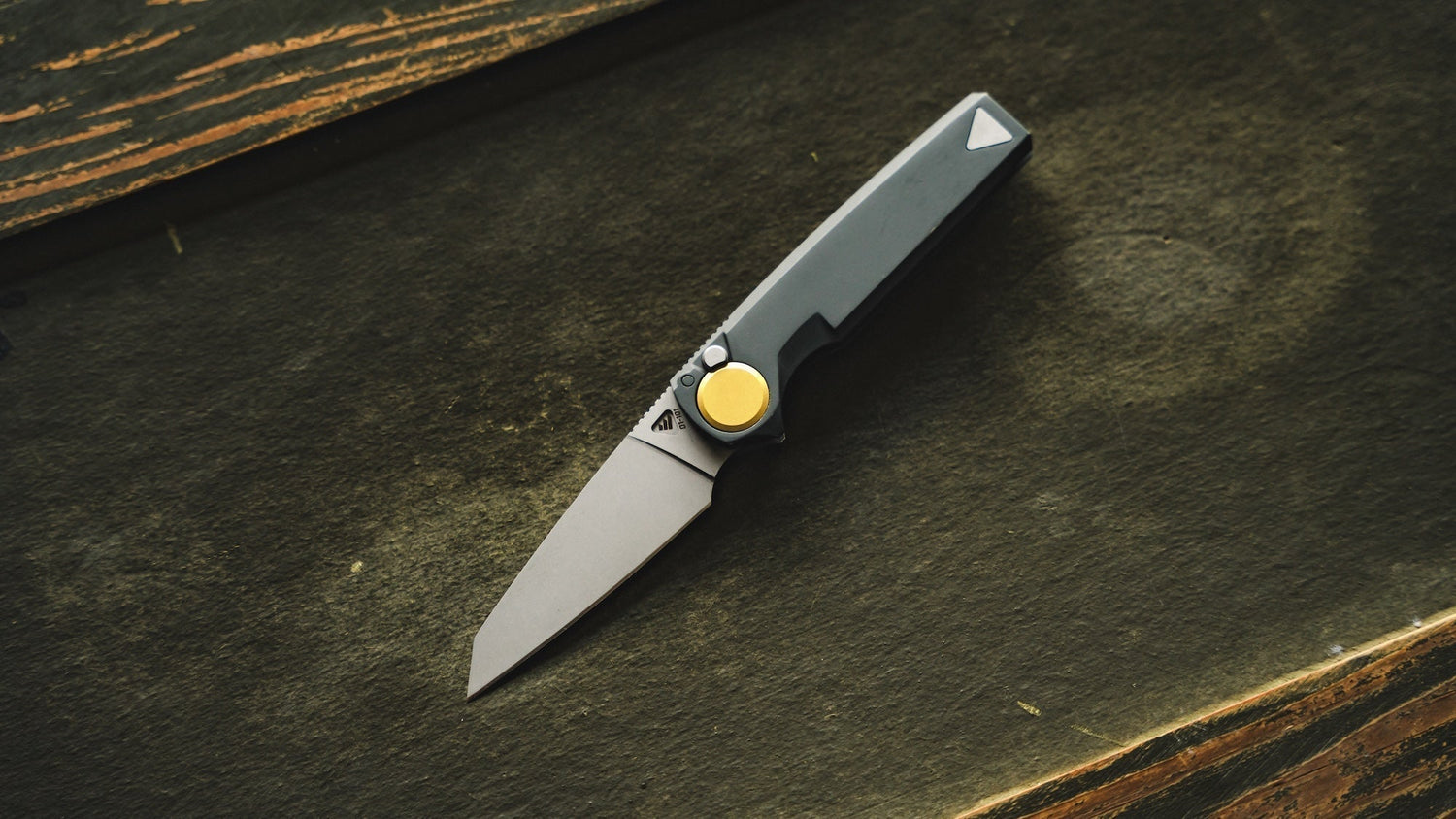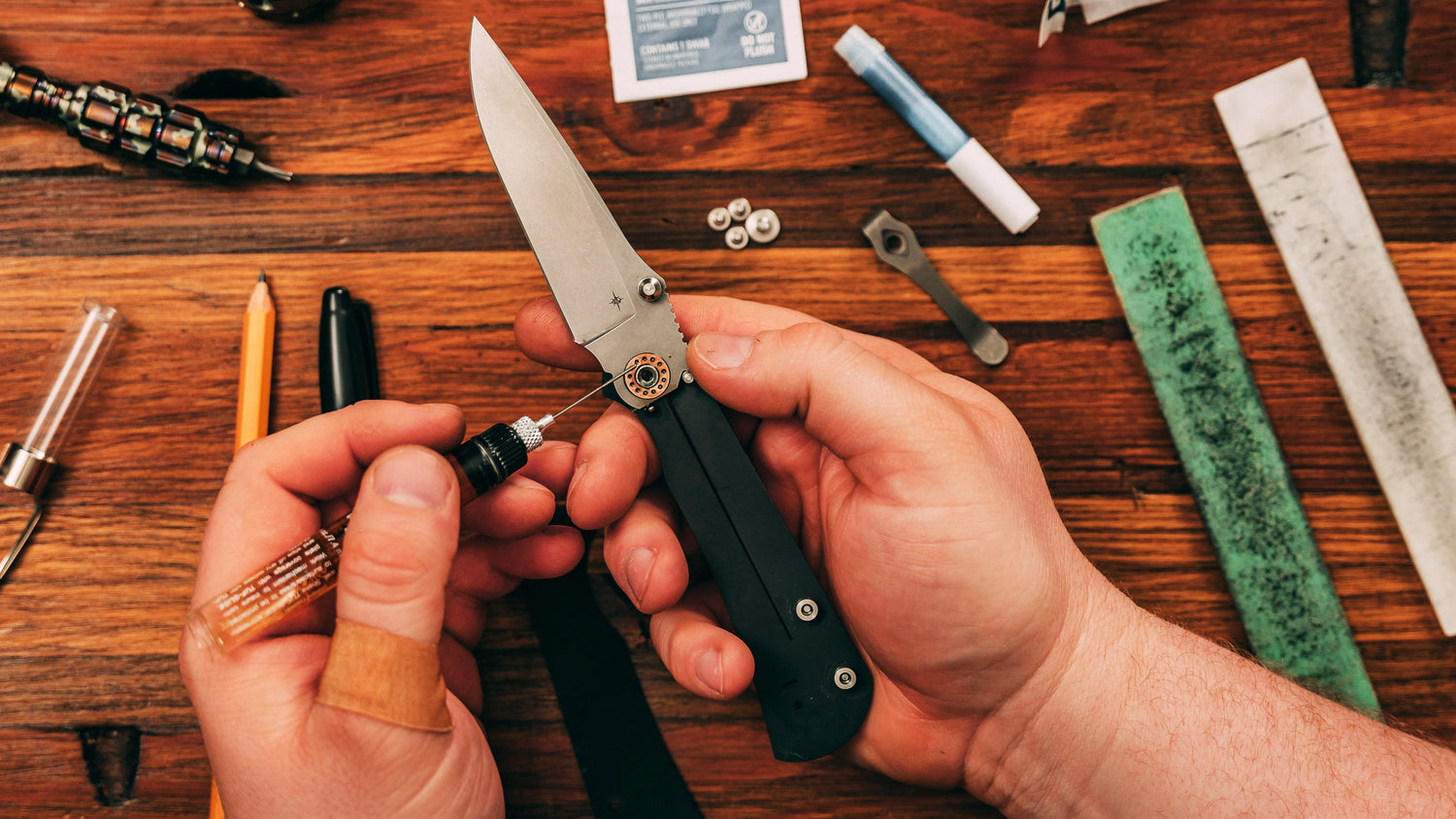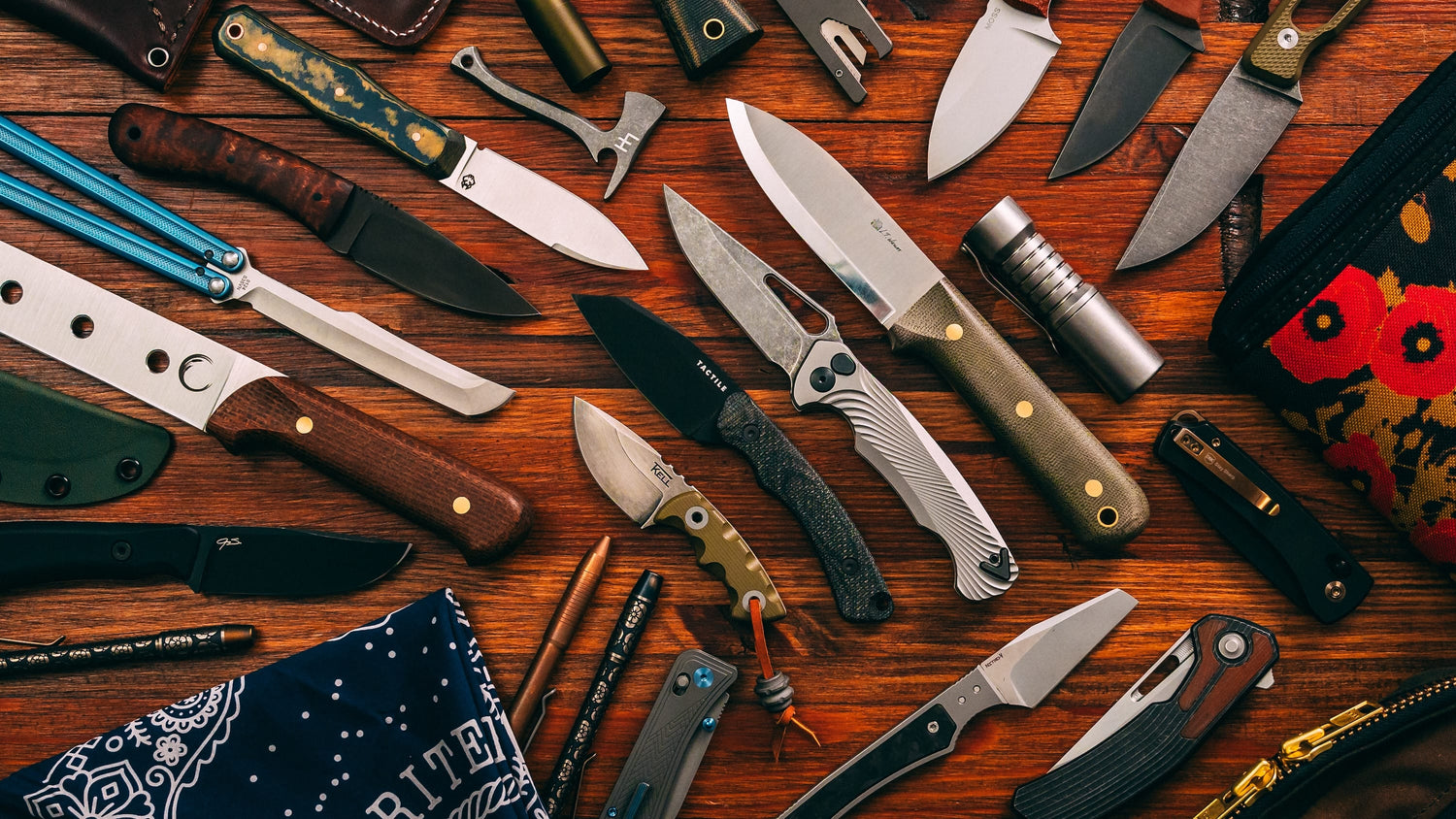When it comes to everyday carry (EDC) knives, everyone seems to be hunting for the deal of a lifetime. Brand names like Benchmade have carved out their niche for making sturdy, American-made folding knives, but with premium pricing.
However, what happens when a $10 Walmart knife is pitted against a $180 industry staple like the Benchmade Bugout? Well, we decided to find out. We took a $10 Ozark Trail folding knife, straight from Walmart, and put it head-to-head against the iconic Benchmade Bugout.
Here’s what happened.
The Contenders: An Unlikely Matchup
Ozark Trail Folding Knife vs. Benchmade Bugout
At first glance, these two knives look remarkably similar. They both sport a clean, minimalist design. But once you pick them up, the differences start to become clear.
The Bugout, features a tried and true S30V steel flat grind blade, which has proven to be a great––albeit somewhat dated––option for nearly any cutting task.
In contrast, the Ozark Trail is equipped with D2 steel. At $10, that's a serious feat. It's a steel that is most commonly found on knives several times more expensive, most famously on the Ontario RAT or one of the most popular modern EDC knives in the last several years, the Civivi Elementum. D2 is a fine steel, especially for the price, but it is known to have some serious flaws, such as chipping or snapping, especially if the heat treat isn't up to snuff.
So in theory, we already know which one is better, right? But is the Bugout 18 times better, as its price suggests? We tested both knives right out of the box through various cutting tasks, and here's what happened.
Handle Quality and Thickness Comparison
We took a moment to compare how these knives feel in hand. On paper, they look like cousins, but you can definitely tell the difference in material quality.
The Bugout has thinner, lightweight Grivory handles that weigh in at just 1.8 ounces.
The Ozark Trail uses injection molded scales on top of full liners. This makes it bulkier and heavier–– it weights a full ounve more than the Bugout.
While this weight difference may not seem critical, the partial liners have drawn quite a bit of criticism for the Bugout. The construction of the Ozark Trail knife feels and looks cheaper, but its full liners definitely make it the more durable handle of the two.
Out-of-the-Box Sharpness
We kicked things off by testing the slicing ability of the knives right out of the box. First up, the Ozark Trail.
-
Ozark Trail initial sharpness: Readings showed it was sharp, with measurements around the 198-208 range on our tester. Impressive.
-
Benchmade Bugout initial sharpness: The Bugout measured 240-248, which came out just slightly more dull than the Ozark, but nothing too dramatic.
Both knives can cut paper and shave hair. You could easily use either for light EDC tasks straight from the package. The question then becomes, how do those edges hold up to light use, hard use, or abuse?
Everyday Cutting Tasks
From here, we moved to real-world cutting scenarios. We sliced through paper, cardboard, Amazon boxes—the kind of stuff you'd use these knives for day to day.
Both knives lost their hair-popping edges about halfway through 50 cuts of cardboard, but could still slice through paper pretty well. The differences here weren't especially notable.
Edge Retention and Touching Up
This is where things got more interesting. After lightly dulling both knives, we touched them up using the WorkSharp Guided Field Sharpener. The aim? To see how easy it was to bring each blade back to that crisp, sharp edge.
- After a few strokes on the ceramic and strop, the Ozark Trail’s D2 steel returned to a respectable 232 sharpness reading, almost back to its factory edge.
- The Bugout, though, was able to be touched up to 198— 20% better than its factory sharpness.
So while both can be sharpened back to functionality somewhat easily, the Bugout demonstrated slightly better edge retention and the ability to be touched up with less effort.
Hard Use Stress Test
While most of our EDC knives see much more than paper and boxes, they're capable of handling quite a bit more than you might expect. So we threw together some tests (some adopted from the Preparonator 3000) to stress the edges of the knives.
Rope, Staples, and Zip Ties
We started with some very common uses cases you might come across on a job site––various thicknesses of string and rope, a staple pry test (not recommended, but something we've all done), rubber hose, zip ties, wire cutting and stripping, and even hammering the edge into a steel cable.
Once we ramped up the intensity, you could immediately feel the difference. Cutting through heavy natural fiber rope was a bit of a fight for the Ozark Trail. It required a lot more effort, but it made it through. However, it bent its tip during a staple test. Outside of those two stumbles, the Ozark Trail held its own.
The Bugout, on the other hand, breezed through all of the cutting tasks and even the prying. When we pried on staples, it didn’t show any permanent damage or bending, even when intentionally applying more force on the tip of the knife.
Both knives sustained edge rolling when they got to the steel cable, but that's nothing a good sharpen can't fix. Only the Ozark Trail knife sustained true damage in this part of the testing––a bent tip––but both knives were still functioning perfectly fine. This one is a small victory for the Bugout, but there was plenty of testing left.
Abuse: Will They Break?
While we may intend to take care of our knives and not abuse them, the truth is, accidents happen. You're getting out of the truck and the knife drops to the ground, you don't realize it and you end up running over it.
So, we took these knives through a series of extreme tests to see how well they held up under pressure.
Drop Tests
Painful, but necessary, we dropped both knives onto asphalt, from various heights, open and closed. We even tossed them 15' into the air, both opened and closed, onto asphalt and gravel.
Surprisingly, both knives managed to keep functioning even after being dropped repeatedly. However, the Ozark Trail did show signs of blade rap. Blade rap is when the blade over-extends when closing and the edge makes contact with a standoff or backspacer––something the edge should never touch. This caused a significant roll on the edge of the Ozark Trail. The action on the knife started to make a rattling sound, even though there was minimal (if any) blade play.
Through all the same tests, the Bugout held up much better, with only minor scuffing.
Running Over the Knives
We also rolled over both knives with a truck, simulating an EDC nightmare.
Both knives were still functional afterward, though the Bugout’s scales started to make a clicking sound. There was no noticeable blade play and the knife still function perfectly, but there were signs that it might have been compromised internally.
Other than a flattened clip, there was no new notable damage on the Ozark Trail after being run over twice.
Snap Tests: The Final Showdown
To finish things off, we decided to step it up a notch. We wanted to test the strength of the blades, so we did a blade bend test by stabbing the knives into a piece of wood and applied lateral force to the blade.
The Bugout was able to be stabbed into the wood and torqued sideways a number of times with no damage whatsoever.
The Ozark Trail, however, (with an already bent tip) was stabbed into the wood and snapped as soon as any lateral force was applied to it. This could have been from micro fractures from dropping it onto asphalt, from the stress of bending the blade in previous tests, or simply because the thinner blade stock and the fact that it's hollow ground. Either way, it snapped very easily.
Finally, I wanted to test something I've always wondered about the Bugout. Can it be broken by hand? So I put on some gloves, gripped the knife from both ends, and bent it as hard as I could. In the first attempt, it make some cracking noises. On the second try, the knife snapped in half, but not past the liners like I had expected. It broke in half in the middle of the liners.
The Ozark Trail fared only somewhat better in this department. Despite having full liners, I was still able to bend the knife significantly––to the point it no longer closed. It's handle now sits at about a 30 degreen angle right by the crossbar lock.
Both knives were rendered useless by the final test. Granted, the only way either of these aspects of durability will ever come into play is if you are grossly misusing your knife.
Conclusion: Is the $10 EDC Knife Worth It?
So, that begs the question: Is the $10 Ozark Trail folding knife worth buying?
Yes. For $10, it's a wildly impressive knife. It shouldn't exist for $10. However, is it better than the Benchmade Bugout?
That question a bit more charged and difficult to answer. I do think the superior quality of the Bugout is immediately apparent when holding the two side by side. Tolerances are tighter, the blade is finished better, the steel is better, etc. But I wouldn't say it's 18 times better than the Ozark Trail.
When you get down to the money aspect, which, let's be honest, is the biggest factor here by a country mile, the Ozark Trail is a cheap knife made in China for as little money as possible. Every corner that can be cut, must be cut. The result, while impressive, is one that will leave you with a knife that will work and will do most of the things you will need it to do. It's so cheap, you can buy a different one for your truck, the house, the shop, your backpack, etc. and still come out cheaper than some of the competition. But make no mistake, it will fail you far faster than the Bugout will.
The Benchmade Bugout is the polar opposite. Despite its very thin and lightweight handle, it's a light-duty EDC knife made in America with a higher-end steel, better QC, and it has a great warranty. However, it's not just expensive, it's seen a nearly 60% price increase since the original Bugout launched. That's a tough pill to swallow for a lot of people.
Is the Bugout 18 times better than the Ozark Trail? No. Will you need 18 replacements of the Ozark Trail to one Bugout? Also, no. But if you need a knife that you can rely on and can not have breaking on you when the going gets rough, you might want to pass on the Ozark Trail. If budget is still of concern, there are countless crossbar lock alternatives in the $30-$75 range, like the Kershaw Iridium, CJRB Hectare, Vosteed Raccoon, or Kizer Drop Bear, that will serve you better than the Ozark Trail.
So answering whether the Ozark Trail knife is better than the Benchmade Bugout isn't a simple “yes or no.” It depends on your perspective. For those who need a cheap knife that can be easily replaced, the Ozark Trail will scratch that itch. It's ridiculously affordable for light EDC use and proves that even budget blades can hold their own for a short while.
On the other hand, the Benchmade Bugout, especially in its aluminum and titanium variants will prove to be a better knife for long-term, albeit a considerable investment. That investment, however, will be one that helps keep industry here in the States by a company that will stand by its product.
What do you think? Would you spend $10 on an Ozark Trail or go for a Bugout? Let us know in the comments. And stay tuned—we've got even more gear tests lined up!





